
We are celebrating 15 years — and counting — of stories that are deeply researched and deeply felt, that build a historical record of what the city has been.
We are celebrating 15 years — and counting — of stories that are deeply researched and deeply felt, that build a historical record of what the city has been.
At Pure House, members get hugs. And yoga. And fresh juice. And, sometimes, massages. House rules include the imperatives to “Show Up,” “Share Your Passions,” and “Nourish Mind / Body / Spirit.” Residents have their own bedrooms but share kitchen, dining, and bathroom spaces, usually with four to five other people. On foot, the company’s Northside Williamsburg apartments are just minutes away from waterfront views of the Manhattan skyline and a host of coffee shops with names like Sweetleaf, Devoción, and Sweatshop.
But while it invites the comparison, Pure House is not a commune, or a fitness center, or a hotel. It is, rather, a wholly familiar housing experience, updated with a Silicon Valley twist. Welcome to co-living, where the hugs are included in the price of your rent.
In the past couple of years, dozens of co-living spaces like Pure House have popped up in cities across the country, offering those in need of single housing what traditional landlord arrangements do not: flexibility, amenities, and, theoretically, community. Although the set-up and decor differs from company to company, co-living spaces in cities like San Francisco, Boston, New York, Los Angeles, and Chicago are united by the same goal: to “disrupt” the urban housing market.
Instead of unresponsive landlords and the crapshoot known as Craigslist, co-living offers roommate-matching with “like-minded” individuals, regular housekeeping, and community events. Founder Ryan Fix sees Pure House’s two Williamsburg properties as a response to a growing trend of people “wanting to be around other people.” Pure House roommates chat over channels on Slack, an office communication tool, to coordinate “walk and talks,” potlucks, hiking, and weekly brunches. At Common, whose first property in Crown Heights opened in October, Wi-Fi and cable, furniture, and shared amenities like toilet paper are included in the monthly rent. There’s a communal projector for movie nights in the basement. One tenant has already started a book club.
Amenities and built-in friendship aside, boosters of co-living say its biggest benefit is adding housing units for single people, which New York City sorely lacks. Singles currently make up a third of New York’s households, and, contrary to popular perception, the majority are not transient millennials on their way to forming nuclear families. Over half of single households are over 55, according to the Citizens Housing & Planning Council (CHPC), a research and policy organization that advocates for a broader definition of households. In New York City, housing for singles remains constrained: strict density controls and roommate regulations have stayed on the books, while the required minimum square footage for apartments has actually increased. Manhattan’s population density, as a result, is the lowest it’s been since 1860.
With the city’s housing stock governed by regulations supporting family-size units, few housing options exist for elderly and young single households alike. When Common’s application system launched in September, it received over a thousand applicants for just 19 rooms. “The response has been tremendous,” Common founder Brad Hargreaves told me. “It speaks to a demand and need for community.” Common introduced its second property in Crown Heights in January and has plans to expand in Brooklyn and to other cities with housing shortages.
While the need for single housing is undeniable, some worry that co-living arrangements will import people seeking flexible, transient, and catered lifestyles into appealing and, for now, relatively affordable neighborhoods. Tenant and affordable housing advocates, in particular, fear that co-living’s approach will exacerbate gentrification in neighborhoods like Crown Heights, where young, white college graduates are already pricing out longer-term African-American, Caribbean, and Caribbean-American residents. In the name of disruption, co-living spaces may end up unsettling established communities.
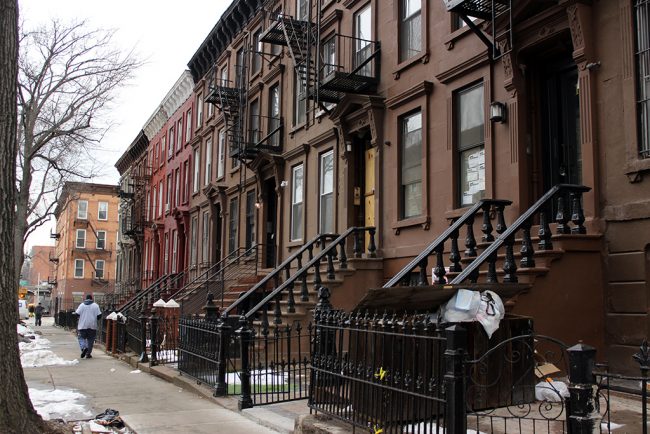
Common’s “Albany Flagship” sits in a row of brownstones on Albany Avenue between Pacific and Dean Streets in Crown Heights. | Photo by Xandra Clark
It’s no coincidence that co-living sounds just like co-working. Many of the developers behind shared working spaces are the same ones churning out experiments in shared housing. But if co-working lets you trade out the office for a couch-filled basement pulsing with ambient deep house music, co-living lets you “do what you love” — as the du jour euphemism for “work” goes — where you live.
Common provides a multipurpose space in the apartment’s basement (where some residents work), while Pure House offers a separate “creative home” called the Kitchen, where a couple of its residents also hold memberships.
In January, co-working empire WeWork began testing its first WeLive space at 110 Wall Street, where the company already rents out office space, desks, and ambience to mid-size businesses and freelance workers on the lower seven floors. In an investor presentation leaked in August, WeWork estimated that WeLive will take in nearly a quarter of the company’s projected revenue, or $605.9 million, by 2018. They’re hoping that 34,000 members will join WeLive within the next three years, co-filling up to 10.3 million square feet across the country.
Common and Pure House’s founders have said they hope to distance the idea of communal living from the idea of work, although both of their concepts emerged from Bay Area start-up and co-working cultures. Before starting Common, Brad Hargreaves co-founded General Assembly, a trade school for twenty-first century skills like coding. He said that one of the biggest questions the company faced was where students were going to live when they came to new cities, especially if they lacked contacts, established credit lines, and formal employment.
Collective living has traditionally been seen as a way to save on rent. Co-living spaces pitch it as a way to make money just by being alive.
Founder Ryan Fix’s idea for Pure House emerged, in part, from problems he diagnosed with the “co-” part of the co-working spaces he helped launch, where people kept their head down, wore earbuds, and rarely interacted or attended events. It wasn’t until he mentored participants in an accelerator program housed in shared dorms that Fix discovered how co-habitation might help people “live in alignment with their passions” — to live what they love.
But whether peddling working, living, or both, WeWork and similar ventures are doing far more than just renting users space: they’re selling community. While the scales of the work-life balance have long been rigged in favor of work, the cleverest disguise for this imbalance was once reserved for the campuses of Silicon Valley giants like Google. Now, even a bootstrapping freelancer can have a taste of the “all work, all play” ethos at these miniaturized campuses: WeWork offers ping pong and beer while WeLive is reported to have on-site laundry, common yoga areas, housekeeping, and built-in social activities, like potluck dinners and game nights.
AirBnB, Uber, and TaskRabbit might cater to your flexible lifestyle, but co-working and co-living let you befriend, collaborate, synergize, and buzzword with like-minded, flexible people. “Being a part of the WeWork community,” advertises the company, “means being surrounded by some of the most innovative and passionate people in the city.” The co-living company Krash, based in Boston, New York, and Washington, D.C., describes its experience as “a particle accelerator for people.” While collective living has traditionally been seen as a way to save on rent, co-living spaces pitch it as a way to make money just by being alive: if you can network with “like-minded” residents and head to your office 24/7, the joy that is work never has to end.
From the perspective of some co-living companies, it seems like there’s no better way to spread the gospel of the “sharing economy” than to cash in on an already booming and informal market of genuine sharing. Unlike your normal, crowded apartment of roommates or serendipitous Craigslist find, any social community you build in the process adds value for the company. The more friends you make, the better the brand is doing at selling friendship, networking, and so on. If the biggest advantage of co-living over Craigslist is its lubrication of insta-community, then what these companies have actually captured is the other side of social media: how to monetize the emotional labor of everyday, non-digital life.
Fix lives in a room in one of his Williamsburg apartments on Kent Street, with four other roommates. When I visited, his common room was decorated eclectically, with large abstract paintings covering most of the white-wall space. Remnants of a tea ceremony were still visible upstairs in a small loft area. Wearing a tropically-colored Ralph Lauren polo and flip-flops, Fix cited the “organizational structure of Burning Man” as an influence on Pure House. “It’s curating incredible people around a shared set of values and putting them in an inspiring place,” he explained.
Before Pure House, Fix worked, among other jobs, in real estate — an experience that he described as “ethically challenging and really hard for my spirit.” Pure House, he said, emerged as an attempt to create a “social experiment” that could “prove we can build a society that can live together.” At that moment, as if on cue, his roommate Sophia walked out in a green towel to head to the shower. When I asked her what she thinks about living at Pure House, she replied, “It’s like being part of a family.” For anyone who’s just moved to the aggressively anonymous city of New York, this type of community might count as “living the dream.”
But in most cases, it’s unclear whether the “co-” prefix in “co-living” refers to actual community or simply close quarters. Critics charge that co-living wields the same communal and collectivist rhetoric used to cleverly rebrand precarious labor as the “sharing economy.” WeWork, for instance, makes no secret of its capitalism dressed up as socialism. Co-founder Adam Neumann grew up on a kibbutz in Israel. “Even though I loved the communal aspect of it,” Neumann told Bloomberg Business, “I didn’t connect to the fact that different people put in different amounts of effort and received the same.” He continued: “On the one hand, community. On the other hand, you eat what you kill.”
Just as Uber has nothing to do with the mutualistic ethos of sharing, there is nothing necessarily communal or inherently place-based about flexible housing. As one Fast Company writer, who lived for eight months in a Park Slope house managed by the now-defunct co-living company Campus, noted: “[It] provides everything you need to avoid settling down: month-to-month rent, roommates, kitchen supplies.” The lack of friction promised by co-living is both seductive and eerie: what’s left of everyday life if you pay not to worry about its basic essentials?
With dish soap, toilet paper, and furniture — what Brad Hargreaves calls the “stuff that roommates fight over” — provided, the living at Common is easy. But Hargreaves has stressed that he doesn’t want his spaces to resemble institutional workplaces, which are by nature “somewhat anti-social.” “This is someone’s home,” he said, “and the risk is that it stops feeling like a home and starts feeling like a dorm.”
Despite these intentions, Common currently feels halfway between a home and a dorm. This might be due to the fact that the five-story walk-up on Pacific Street has been recently renovated; the rooms run along a hallway that leads away from the living room to maximize privacy. The Crown Heights building also comes equipped with college-reminiscent keycard swipes, comfortable pre-bought furniture, and a collegiate helping of bike storage. A long table for co-working or co-dining runs the length of the building’s downstairs communal space, whose walls are “sourced” with local art. “You’re living in Brooklyn,” Hargreaves emphasized. “A sense of place is so important.”
But what sense of place is Common selling, exactly? Common’s goal, as Hargreaves explained over e-mail, is “to create a network of Common residences so that members have access to housing options throughout the country and can connect personally and professionally with members in other cities.” Similar co-living companies have stated that they want tenants to sign one membership agreement that allows them to seamlessly move between company-held buildings, and even cities, in the future.
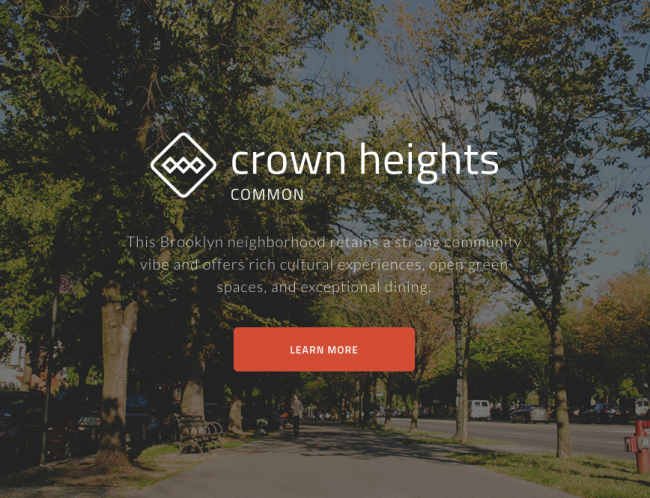
Common’s website advances a brand for the neighborhood of Crown Heights as it does its service. | Screenshot from Common website, February 2016
Cea Weaver, who works with tenants to form affordable co-ops in Brooklyn and Manhattan, says she is troubled by the lack of commitment required by those signing up for some of the month-to-month co-living spaces. “If you’re moving in and moving out, what impact are you going to have in your community?” she asked. “You might not even vote.”
The flexibility of these arrangements is often echoed by the structure of the companies themselves, who do not own the buildings but instead operate more as concierges with long-term leases. WeWork’s “asset-light” approach to desk-sharing involves exclusively leasing all of its properties.
No matter where its furnishings are plopped down, the comfort of a company’s recognizable brand — its signature aesthetic interiors and like-minded roommates — will remain unchanged. The aim of co-living, in this light, appears to be a sense of placelessness, not place.
Affordable housing advocates warn that co-living’s model of subleasing units will artificially inflate rent and exacerbate the already rapid pace of gentrification in neighborhoods like Crown Heights. “[Common] seems to me this insta-community where they’re providing you with these spaces to have ‘bohemian energy,’” said Charlotte Bell, the assistant director of co-op preservation with the Urban Homesteading Assistance Board (UHAB). “But we already have people in these spaces with communities. This doesn’t solve the problem of those people being pushed out.”
Residents in gentrifying neighborhoods often face illegal pressures to move out, like landlords withholding repairs, so that their units can be renovated and removed from rent stabilization, allowing the rent to be doubled or tripled. According to an analysis of the 2010 census released by the Department of City Planning, Crown Heights, Flatbush, and Prospect-Lefferts Gardens each lost 10 to 14 percent of their black populations between 2000 and 2010. Meanwhile, the white population of Bedford-Stuyvesant, just north of Crown Heights, grew by 633 percent in that same period, according to the 2010 census.
Bell worries that the “just add water” approach of co-living will accelerate the exodus of long-term residents by raising the market rent and appeal of the neighborhood. “It’s maybe applying innovative housing solutions for a certain group of young, transient professionals, but the fact of the matter is that that’s a subset of this city,” Bell said. “Properties that could go into another avenue of long-term affordable housing are going to young professionals instead.”
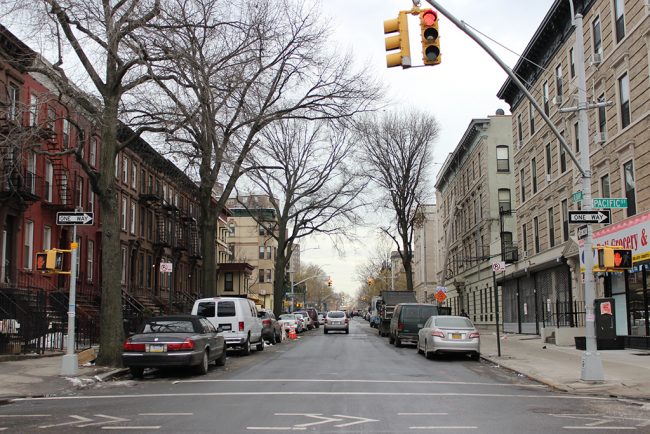
Albany Avenue, looking south from Pacific Street. Common’s “Albany Flagship” sits within the row of brownstones to the left. | Photo by Xandra Clark
Housing policy advocates like Weaver argue that new investments must be coupled with affordability protections for residents already living in high-growth neighborhoods. New York endured a net loss of more than 150,000 rent-regulated apartments between 1994 and 2012, while the city added more than a million residents.
Co-living rent is not cheap. Bedrooms run up to $1,900 at Common’s “Pacific Flagship” property. (For comparison, nearby four-bedroom apartments listed on Naked Apartments averaged about $2,800). Fix says his price is unbeatable — as far as rooms in the heart of Williamsburg go. Spots at Pure House are priced online between $1,500 and $2,000 a month, depending on the number of amenities residents select. When I asked Hargreaves about Common’s rent, he said that it was “an output, not an input” — meaning that it was difficult to compare Common’s monthly rent to traditional rents because of its built-in amenities and differences from traditional housing. Hargreaves added that Common’s plan is to only purchase vacant buildings not currently in use.
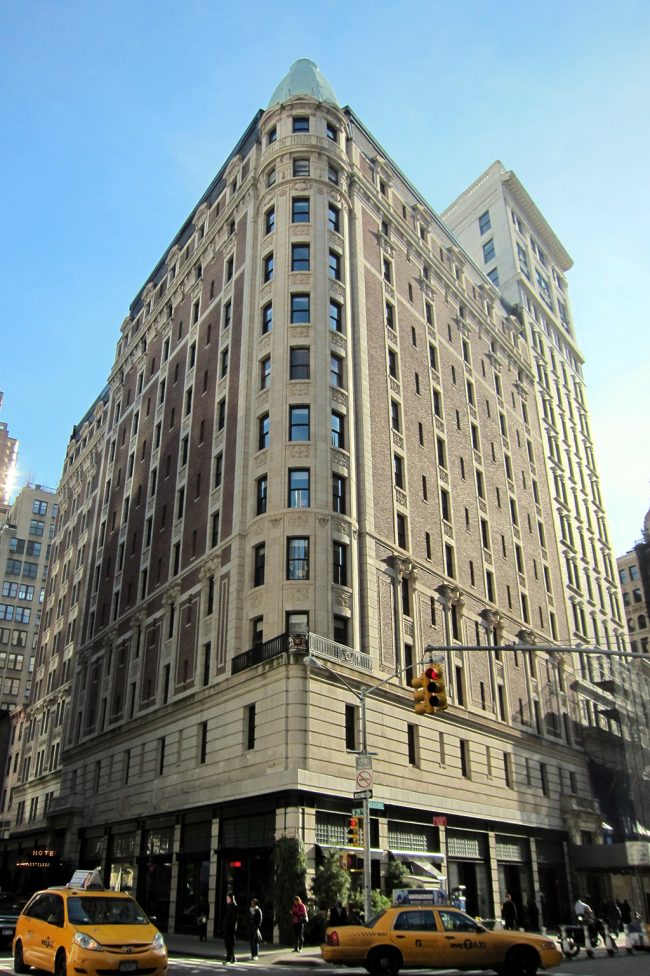
The current location of the Ace Hotel in the Flatiron District was once operated as a single room occupancy residence and still houses some rent-stabilized tenants. | Photo by Wally Gobetz
But according to housing policy experts, shared housing should not have to fetch a large price tag. Models with both a community ethos and affordability already exist. The limited equity cooperative model allows long-term and low-income residents to cooperatively govern and operate their buildings. These Housing Development Fund Corporation (HDFC) co-ops serve as a check against gentrification by allowing low-income residents to control their housing and re-invest in their neighborhoods.
Single-room occupancy residences, or SROs, which were established in the late nineteenth and early 20th century to provide affordable housing for single tenants, may also present another affordable and sustainable alternative to co-living. As in co-living spaces, many SRO tenants have their own bedrooms but share kitchen and bathroom areas. But ever since the creation of new SROs in New York City was outlawed in the 1950s, the units have suffered from a bad rap. Many SROs were regulated out of existence and converted into more profitable uses in the second half of the twentieth century. Others, suffering from decreased investment, left their residents with increasingly poor living conditions. To stop SRO creation, city law currently bars landlords from renting out individual rooms in apartments.
Following a complaint in November, Common was investigated by the Department of Buildings for its similarity to an SRO. While the DOB determined that Common was not a fancy version of this existing housing type — notable differences include the fact that Common rooms do not have locks on the doors and a new group lease is co-signed every time a new tenant moves in — the comparison may still be useful for thinking about historically affordable options for single housing, ones that could serve a broader segment of the population.
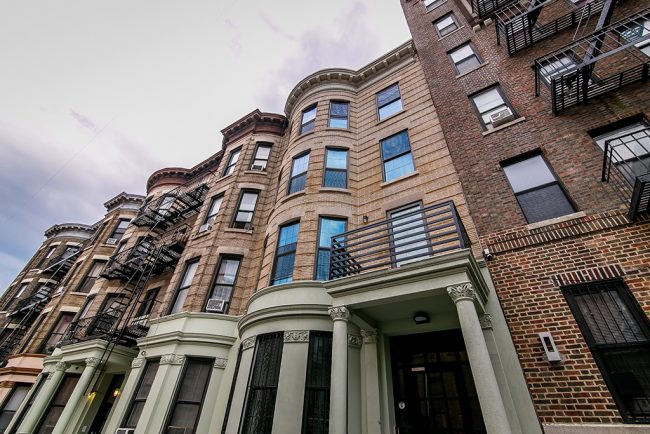
Common’s “Pacific Flagship” on Pacific Street between Bedford and Franklin Avenues in Crown Heights | Photo courtesy of Common
Sarah Watson, Deputy Director of the CHPC, attributes the current, “overinflated” prices of co-living and micro-housing to a lack of available options, which creates a high demand across all prices. “There used to be safe, legal options for people to live in the city, like SROs and the YMCA. There used to be more diverse options,” Watson said. “Now, there’s nowhere you can go as a single person. If you break up with a partner where do you go? So you’re always pushed into this informal world where the pricing is weird.”
SRO or no, co-living’s informality may present other legal hiccups. While hundreds of thousands of people informally share housing in the city, occupancy rules technically bar three or more unrelated people from doing so. This ostensibly presents a major barrier to the planned development of shared housing for non-families.
The Fair Housing Act, which forbids landlords from discriminating against potential tenants based on age, race, sex, religion, disability, familial status, or national origin, could also present another barrier to co-living disruption. Co-living’s application process collects more information on potential tenants than a typical landlord does, including what applicants are willing to pay for rent. And it’s possible that the selection practices that follow could run afoul of the FHA if they were shown to narrowly select for a specific demographic.
To date, co-living companies have not released demographic data on the types of people who occupy their spaces. However, many of the co-living founders I spoke with said that, save for the fact that tenants skew younger, their houses have nothing in common with the homogeneity of “hacker houses” of yore — spaces where mostly male, mostly white millennials would crash to collaborate on ideas for start-ups and changing the world. Common and Pure House stated that they’ve gotten interest across demographic profiles and select tenants primarily based on their positive attitude and interest in co-habitating.
Prospective Common members — who range in age from 19 to 43 — submit an application, undergo a criminal background check, and go through an interview process. When asked about the company’s selection process, Hargreaves explained that Common is “looking for people who want to be part of a community and are seeking to actively participate in our events and want to get to know their neighbors.” He added that the company’s Pacific Street residents are currently representative of New York City’s diversity.
At Pure House, the professions (or as Fix says, “passions”) of current residents range from ad sales for a tech company to meditation coaching to writing to architecture. Fix likewise selects residents based on an application review and interview. He said that while elderly residents, couples, and single mothers do apply less frequently, Pure House has happily hosted all three.
Matthew Lasner, Professor of Urban Policy and Planning at Hunter College, thinks that it’s unlikely the companies will be found to violate the Fair Housing Act. Enforcers of the Fair Housing Act have historically turned a blind eye to co-ops and other screening processes since the 1950s, he explained. “You can screen, as long as you don’t discriminate against people,” he said. But selecting without discriminating, he added, might be a slippery slope.
The rise of co-living, Lasner continued, underscores the continued need for “flexible short-term accommodation” in the 21st century. “In some ways, co-living is very new,” he said, “and in some ways this is a very old story. Young, unattached, unmarried single people have been coming into cities and trying to make the rent in different ways for a long time.”
Within this lengthy history, co-living’s attempt to disrupt, once and for all, who buys the toilet paper or how to break a lease when somebody moves out may seem trivial. But the movie nights and household tasks that co-living capture are in fact immensely valuable—and, if monetized in the vein of co-working, quite profitable. As co-living dresses up community and the informal dross of everyday life as innovation, it’s worth wondering at whose cost.
The views expressed here are those of the authors only and do not reflect the position of The Architectural League of New York.